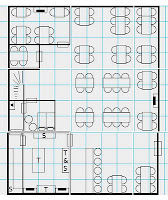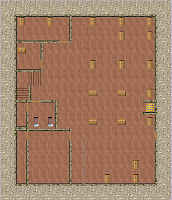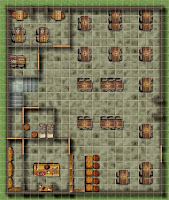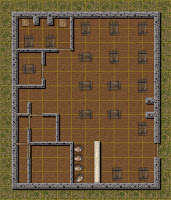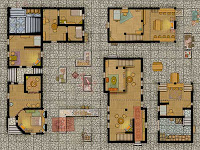The Deck of Many Things (aka RPG History 101)
As many of you will know playing cards have been used as physical representations of the cards in the classic deck of many things since its inception. The first published reference of the use of tarot dates back to 1983 where Michael J. Lowrey codified its use in AD&D in his article published in Dragon #77. It's also in the D&D SRD so as far as I'm concerned it's cannon!!
Presenting your players with a tattered tarot deck lends an air of theatricality and mystique to your game which will not go unnoticed by your players.
Tarot as a Character Generation Tool
Surprisingly there was a time before the 5e Background Generator and some players always seem to have difficulty coming up with interesting motivations for their PCs. I have often used a much simplified version of the Celtic Cross Spread to help them to generate their own ideas for their characters background and motivations.
 |
| A typical shortened "Celtic Cross" spread using only the 22 Major Arcana "Picture" cards |
The first card laid is the "Significator" and describes the PCs current state. In Tarot terms this is often described as the question that the appellant is asking of the cards. For example a Fool in this position may indicate that the PC is a happy go lucky type of person blissfully ignorant of their place in the world or it could mean that they are quite literally the village idiot.
The second card (The crossing) covers the first and identifies that which currently opposes the PC. In other words the thing which must be overcome if the PC is to realise their goal. This can often suggest some sort of personality or circumstance change which the PC must achieve. For example a Tower in this position may mean that only by experiencing a disaster or tumultuous event will the PC be able to achieve their goal. A devil on the other hand may signify the acquisition of power and wealth or the casting off of material possessions in order to fulfil ones potential.
The third card represents the factors which are the foundation for the PCs current state these are considered to be the the things upon which the PC can rely upon such as their family or their own skills and strengths. A "good" card such as The Emperor may mean that the PC has strength of focus or that they have an imposing father figure which they can rely upon. A "bad" card such as the hanged man may signify that the PC holds an outdated opinion or principle or that they have had the strength to make a significant change in their life such as letting go of a previous life or relationship.
The fourth card represents the PCs immediate past, events which may have happened very recently which have influenced the PCs current position. A Tower in this position may signify a disaster from which the PC has fled with their life. A Moon may signify that the PC has recently had an emotionally charged romantic relationship, also which they are fleeing or perhaps they are being chased by a lover (or more likely the lover's father).
The fifth card signifies the PCs immediate future, that which may come to pass irrespective of the PCs actions within the next few days. This is something of a gift for the DM and I often use it as a mechanism to gift the player a plot hook or some sort of advance knowledge which they can use in an upcoming encounter. Of course to be really effective it should also be intentionally vague and mean little or nothing to the player initially. Consider this to be the "you will meet a dark stranger" moment of the reading.
The sixth card represents the best possible outcome or as I like to think, the PCs ultimate goal or desire. This card is probably the most important in the spread as it directly influences the PCs motivations. A Judgement card in this position may well signify that the PC is mindful of their mortality and wishes to do good deeds to prepare for their own accounting before their chosen deity. A Hermit in this position may mean that the PC seeks isolation, retrospection in the pursuit of the search for truth.
As you can see from the example interpretations of the cards, they offer an almost infinite number (53,721,360 to be exact) of permutations and potential ideas for even the most jaded old school player who bears the scars of a thousand personalities.
Insta-Deck of Fate
There are those times in a game when the party are on their last legs and hope is something which has long since put on it skedaddle trousers and exited stage right. This is when you ask one of their number to draw a card from the fate deck.
Use this as an opportunity to introduce a new game saving factor relevant to the card. For example a prone hero about to be beheaded by a nefarious bad guy draws the Heirophant and the bad guy suddenly has a pang of conscience and decides to do the right thing and pauses… leaving them wide open for a killing blow.
My advice is to use this sparingly and only in dire circumstances to avoid a meaningless and game altering character death, otherwise the players may begin to consider their characters as somewhat immortal.
The Dream Sequence
I have also used tarot cards to project PC dreams, visions or hallucinations. How the players interpret the cards is up to them, but at least it gives an player something to reflect on as the blood slowly drains from their PCs unconscious body. Perhaps it includes some insight into their current predicament or some final sage advice about mending their ways should they be restored to health by their comrades, you choose what it really means.
The Story Generator
In much the same way as in the character generation above, the Tarot can be used during the plot generation process. Draw a few cards to generate a handful of significant NPCs around which the plot revolves and then do Celtic Cross spreads for each of these. The goals and obstacles that they must overcome will often suggest some sort of contested relationship in much the same way as players generate relationships, needs, objects and locations between each other during setup in a game of FIASCO.
For those readers who feel uncomfortable with using a Tarot, I can heartily recommend the use of Inkwell Ideas Encounter Decks which contain a wide variety of story ideas. Vintage accessories such as the "Whimsy" or Story Path Cards also have potential for storyboarding your games.
Indie RPG fans may also be familiar with the innovative storytelling map drawing game, The Quiet Year, which uses a standard playing card deck to generate weekly events which shape a world and its inhabitants. Many of these events can be lifted directly from the game to create world shaping events for your own campaign.
Interpreting the Cards
I recommend only using the 22 major arcana cards mostly because these are the pretty ones but also because it's a lot easier to just reference the 44 different meanings (each card has 2 orientations Upright and Reversed) rather than the 156 of a full deck.
The tarot card meanings are intentionally vague and are supposed to inspire associations in the mind of the appellant (the player) and the reader (the GM) is merely using it as a device to stimulate creativity. Many of the meanings are allegorical based on the significance of the objects found in the images.
For example the Fool is often depicted being followed by a dog which signifies unconditional love. The hanged man is usually depicted tied by one leg which harks back to medieval punishment for traitors. These symbols may of course mean something else to the appellant and cause them to imagine some other significance for their PC. There are a plethora of resources for Tarot meanings including handy reference apps for the mobile gamer.
A Final Word about Death, Devils and Towers
The appearance of the Death card is often followed swiftly by a sharp intake of breath. In tarot terms the Death card actually signifies the end of a phase of life and a transition to something new. Interpreting this card as PC death, particularly if it appears in the fifth position of the spread described above should be avoided.This should also be the case with the Devil and Tower cards which also signify disturbance or change rather than a career ending catastrophe.
Thanks of course go to Of Dice and Dragons for continuing to promote the RPG Blog Carnival. This is my 5th entry and you can read the rest by clicking the RPG Blog Carnival tag below.






























